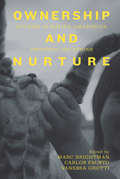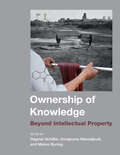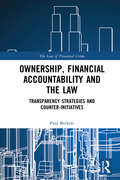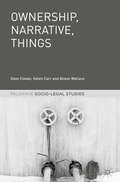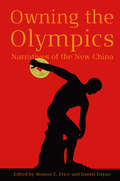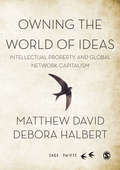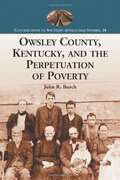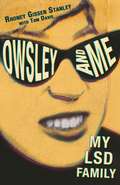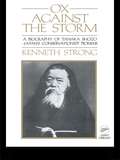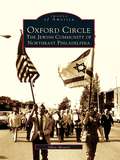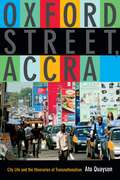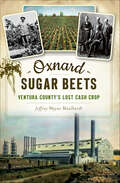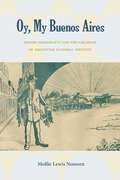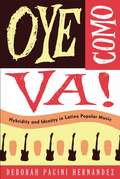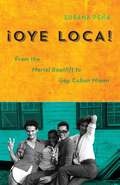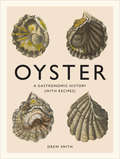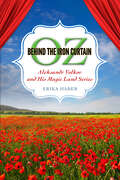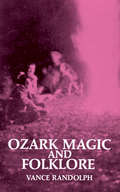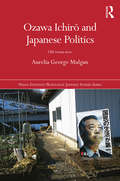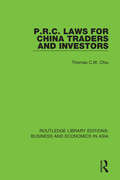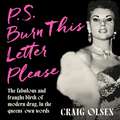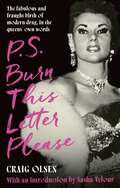- Table View
- List View
Ownership and Nurture: Studies in Native Amazonian Property Relations
by Marc Brightman Vanessa Grotti Strong Carlos FaustoThe first book to address the classic anthropological theme of property through the ethnography of Amazonia, Ownership and Nurture sets new and challenging terms for anthropological debates about the region and about property in general. Property and ownership have special significance and carry specific meanings in Amazonia, which has been portrayed as the antithesis of Western, property-based, civilization. Through carefully constructed studies of land ownership, slavery, shamanism, spirit mastery, aesthetics, and intellectual property, this volume demonstrates that property relations are of central importance in Amazonia, and that the ownership of persons plays an especially significant role in native cosmology.
Ownership of Knowledge: Beyond Intellectual Property
by Dagmar Schäfer, Annapurna Mamidipudi, and Marius BuningA framework for knowledge ownership that challenges the mechanisms of inequality in modern society.Scholars of science, technology, medicine, and law have all tended to emphasize knowledge as the sum of human understanding, and its ownership as possession by law. Breaking with traditional discourse on knowledge property as something that concerns mainly words and intellectual history, or science and law, Dagmar Schäfer, Annapurna Mamidipudi, and Marius Buning propose technology as a central heuristic for studying the many implications of knowledge ownership. Toward this end, they focus on the notions of knowledge and ownership in courtrooms, workshops, policy, and research practices, while also shedding light on scholarship itself as a powerful tool for making explicit the politics inherent in knowledge practices and social order. The book presents case studies showing how diverse knowledge economies are created and how inequalities arise from them. Unlike scholars who have fragmented this discourse across the disciplines of anthropology, sociology, and history, the editors highlight recent developments in the emerging field of the global history of knowledge—as science, as economy, and as culture. The case studies reveal how notions of knowing and owning emerge because they reciprocally produce and determine each other&’s limits and possibilities; that is, how we know inevitably affects how we can own what we know; and how we own always impacts how and what we are able to know.ContributorsDagmar Schäfer, Annapurna Mamidipudi, Cynthia Brokaw, Marius Buning, Viren Murthy, Marjolijn Bol, Amy E. Slaton, James Leach, Myles W. Jackson, Lissant Bolton, Vivek S. Oak, Jörn Oeder
Ownership, Financial Accountability and the Law: Transparency Strategies and Counter-Initiatives (The Law of Financial Crime)
by Paul BeckettThere is something visceral about ownership. This is mine; you can’t have it. This is mine; you can share it. This is ours. Try to find it. Contemporary literature and investigative journalism are showing that the scale of the problem of tax evasion, money laundering, organised crime, terrorism, bribery, corruption and gross human rights abuses is vast. Ownership – specifically, the quest to identify beneficial owners - has been chosen by national and international regulators as the touchstone, the litmus test in the fight back. An owner by definition must possess something for which they are financially accountable. But what is meant by "ownership"? This book explains why ownership is pivotal to accountability, and what ownership means in common law, civil law and Shariah law terms. It looks in detail at State, regional and international transparency strategies and at an equally powerful global private counter-initiative to promote beneficial ownership avoidance through the use of so-called "orphan structures". Where there is no owner, there is no accountability. The distinction between privacy and legitimate confidentiality on the one hand, and concealment on the other is explained with reference to commercial and trade law and practice, principles of corporate governance and applicable business human rights. This book introduces one further counter initiative: the phenomenon of transient ownership made possible through the use of cryptocurrency and the blockchain. The study concludes with a blueprint for action with recommendations addressed to states, international organisations, practitioners and other stakeholders.
Ownership, Narrative, Things (Palgrave Socio-Legal Studies)
by Helen Carr Dave Cowan Alison WallaceThis book uses a case study of a low-cost home ownership initiative at the margins of renting and owning provided by social landlords – known as shared ownership – to challenge everyday assumptions held about the ‘social’ and the ‘legal’ in property. The authors provide a study of the construction of property ownership, from the creation of this idea through to the present day, and offer a fresh consideration of key issues surrounding property, ownership, and the social.Analysing a diverse range of sources (from archives to micro-blogs, observation of housing providers, and interviews with shared owners), the authors explain the significance of the things (from the formal documents like leases, to odd materials like sweet wrappers and cigarette butts) commonly found in the narratives around shared ownership which are used to construct it as private ownership in everyday life. Ultimately, they uncover how this dream of ownership can become tarnished when people’s identities as ‘owners’ come under threat, and as such, these findings will provide fascinating insight into the intricacies of so-called home ownership for scholars of Law, Criminology, and Sociology.
Owning the Olympics: Narratives of the New China
by Daniel Dayan Monroe PriceFrom the moment they were announced, the Beijing Games were a major media event and the focus of intense scrutiny and speculation. In contrast to earlier such events, however, the Beijing Games are also unfolding in a newly volatile global media environment that is no longer monopolized by broadcast media. The dramatic expansion of media outlets and the growth of mobile communications technology have changed the nature of media events, making it significantly more difficult to regulate them or control their meaning. This volatility is reflected in the multiple, well-publicized controversies characterizing the run-up to Beijing 2008. According to many Western commentators, the People's Republic of China seized the Olympics as an opportunity to reinvent itself as the "New China"---a global leader in economics, technology, and environmental issues, with an improving human-rights record. But China's maneuverings have also been hotly contested by diverse global voices, including prominent human-rights advocates, all seeking to displace the official story of the Games. Bringing together a distinguished group of scholars from Chinese studies, human rights, media studies, law, and other fields, Owning the Olympics reveals how multiple entities---including the Chinese Communist Party itself---seek to influence and control the narratives through which the Beijing Games will be understood.
Owning the World of Ideas: Intellectual Property and Global Network Capitalism (SAGE Swifts)
by Matthew David Debora HalbertFormally, ownership of ideas is legally impossible, and can never be globally secured. Yet, in very real and significant ways these limits have been undone. In principle, ideas cannot be owned, yet, undoing the distinction between ideas and tangible manifestations, the distinction which underpins the principle, allows the principle to hold even whilst its meaning is hollowed out. Post-Cold War global network capitalism is premised upon regulatory structures designed to enforce deregulation in global markets and production, but at the same time to enforce global regulation of property and intellectual property in particular. However, this roll-out has not been without resistance and limitations. Globalization, the affordances of digital networks, and contradiction within capitalism itself - between private property and free markets - promote and undo global IP expansion. In this book David and Halbert map the rise of global IP protectionism, debunk the key justifications given for IPRs, dismiss the arguments put forward for global extension and harmonization; and suggest that roll-back, suspension, and even simply the bi-passing of IP in practice offer better solutions for promoting innovation and meeting human needs.
Owning the World of Ideas: Intellectual Property and Global Network Capitalism (SAGE Swifts)
by Matthew David Debora HalbertFormally, ownership of ideas is legally impossible, and can never be globally secured. Yet, in very real and significant ways these limits have been undone. In principle, ideas cannot be owned, yet, undoing the distinction between ideas and tangible manifestations, the distinction which underpins the principle, allows the principle to hold even whilst its meaning is hollowed out. Post-Cold War global network capitalism is premised upon regulatory structures designed to enforce deregulation in global markets and production, but at the same time to enforce global regulation of property and intellectual property in particular. However, this roll-out has not been without resistance and limitations. Globalization, the affordances of digital networks, and contradiction within capitalism itself - between private property and free markets - promote and undo global IP expansion. In this book David and Halbert map the rise of global IP protectionism, debunk the key justifications given for IPRs, dismiss the arguments put forward for global extension and harmonization; and suggest that roll-back, suspension, and even simply the bi-passing of IP in practice offer better solutions for promoting innovation and meeting human needs.
Owsley County, Kentucky, And The Perpetuation Of Poverty (Contributions To Southern Appalachian Studies #18)
by John R. BurchOwsley County, Kentucky, is well known by journalists, academics, and local historians as a quintessential example of rural poverty in Appalachia. This study identifies several reasons behind Owsley County's ongoing struggle with poverty, including the county's lack of natural resources, a poor transportation system, and a centralized socio-political power structure controlled by the entrenched elite. The author asserts that Owsley County's economic hardships are far from unique, but rather are representative of a significant number of Appalachian counties and towns. Several tables and appendices provide useful demographic, legislative, and agricultural data.
Owsley and Me
by Tom Davis Rhoney Gissen StanleyOwsley and Me is a love story set against the background of the Psychedelic Revolution of the '60s. Owsley "Bear" Stanley met her in Berkeley in 1965, when LSD was still legal and he was the world's largest producer and distributor of LSD. Rhoney found herself working in an LSD laboratory, and the third corner in a love triangle. We all know the stories from the '60s-but never from the point of view of a woman finding her way through twisted trails of love, jealousy, and paranoia, all the while personally connecting to the most iconic events and people of her time.Bear supported the Grateful Dead in their early years and gave away as much LSD as he sold-millions of hits. He designed and engineered the infamous Wall of Sound system of the early '70s, just before he began his two years in prison, with Rhoney raising their infant son. He died one year ago, but the era he helped create is now being rediscovered by a new generation interested in the meaning of it all.Today Rhoney Stanley is a practicing holistic orthodontist in Woodstock, New York. This is her first book.Tom Davis was an Emmy Award-winning American writer and comedian. He is best known for being one of the original writers for Saturday Night Live and for his former partnership with Al Franken, as half of the comedy duo "Franken & Davis." His memoir Thirty-Nine Years of Short-Term Memory Loss: The Early Days of SNL from Someone Who Was There was published in 2010 by Grove Press.
Ox Against the Storm: A Biography of Tanaka Shozo: Japans Conservationist Pioneer
by Kenneth StrongRecounts the lifelong struggle of the 19th-century pioneer environmental conservationist.
Oxford Circle: The Jewish Community of Northeast Philadelphia (Images of America)
by Allen MeyersThe Jewish community of Northeast Philadelphia was created by the relocation of secondgeneration eastern European Jews from the neighborhoods of Strawberry Mansion and South, North, and West Philadelphia. Serving more than one hundred thousand Jewish residents at its height, Northeast Philadelphia consisted of ten distinctive neighborhoods, including Feltonville, Oxford Circle, Tacony, and Mayfair. During the twentieth century, thousands of Jewish families were attracted to the area by the houses built along Roosevelt Boulevard for soldiers returning home from World War II. Welsh Road catered to younger families, and wealthier families resided along Bustleton Avenue and Fox Chase and Verree Roads. Today, the influx of strictly orthodox Jewish residents has given rise to a third generation of Jewish life in Northeast Philadelphia.
Oxford Street, Accra: City Life and the Itineraries of Transnationalism
by Ato QuaysonIn Oxford Street, Accra, Ato Quayson analyzes the dynamics of Ghana's capital city through a focus on Oxford Street, part of Accra's most vibrant and globalized commercial district. He traces the city's evolution from its settlement in the mid-seventeenth century to the present day. He combines his impressions of the sights, sounds, interactions, and distribution of space with broader dynamics, including the histories of colonial and postcolonial town planning and the marks of transnationalism evident in Accra's salsa scene, gym culture, and commercial billboards. Quayson finds that the various planning systems that have shaped the city--and had their stratifying effects intensified by the IMF-mandated structural adjustment programs of the late 1980s--prepared the way for the early-1990s transformation of a largely residential neighborhood into a kinetic shopping district. With an intense commercialism overlying, or coexisting with, stark economic inequalities, Oxford Street is a microcosm of historical and urban processes that have made Accra the variegated and contradictory metropolis that it is today.
Oxnard Sugar Beets: Ventura County's Lost Cash Crop (Lost)
by Jeffrey Wayne MaulhardtIn the early 1890s, farmers Albert Maulhardt and John Edward Borchard discovered Ventura County's favorable conditions for a highly profitable new cash crop: the sugar beet. Not long after inviting sugar mogul Henry T. Oxnard to the area, construction began on a $2 million sugar factory capable of processing two thousand tons of beets daily. The facility brought jobs, wealth and the Southern Pacific rail line. It became one of the country's largest producers of sugar, and just like that, a town was born. Despite the industry's demise, the city of Oxnard still owes its name to the man who delivered prosperity. A fifth-generation descendant, local author and historian Jeffrey Wayne Maulhardt details the rise and fall of a powerful enterprise and the entrepreneurial laborers who helped create a city.
Oxygen: The Molecule That Made the World
by Nick LaneNick Lane shows how oxygen underpins the origin of biological complexity, the birth of photosynthesis, the evolution of animals, the need for two sexes, the aging of cloned animals like Dolly the sheep, and the surprisingly long lives of birds.
Oy, My Buenos Aires: Jewish Immigrants and the Creation of Argentine National Identity
by Mollie Lewis NouwenBetween 1905 and 1930, more than one hundred thousand Jews left Central and Eastern Europe to settle permanently in Argentina. This book explores how these Yiddish-speaking Ashkenazi immigrants helped to create a new urban strain of the Argentine national identity. Like other immigrants, Jews embraced Buenos Aires and Argentina while keeping ethnic identities—they spoke and produced new literary works in their native Yiddish and continued Jewish cultural traditions brought from Europe, from foodways to holidays. The author examines a variety of sources including Yiddish poems and songs, police records, and advertisements to focus on the intersection and shifting boundaries of ethnic and national identities.In addition to the interplay of national and ethnic identities, Nouwen illuminates the importance of gender roles, generation, and class, as well as relationships between Jews and non-Jews. She focuses on the daily lives of ordinary Jews in Buenos Aires. Most Jews were working class, though some did rise to become middleclass professionals. Some belonged to organizations that served the Jewish community, while others were more informally linked to their ethnic group through their family and friends. Jews were involved in leftist politics from anarchism to unionism, and also started Zionist organizations. By exploring the diversity of Jewish experiences in Buenos Aires, Nouwen shows how individuals articulated their multiple identities, as well as how those identities formed and overlapped.
Oye Como Va!: Hybridity and Identity in Latino Popular Music
by Hernandez Deborah PaciniListen Up! When the New York-born Tito Puente composed "Oye Como Va!" in the 1960s, his popular song was called "Latin" even though it was a fusion of Afro-Cuban and New York Latino musical influences. A decade later, Carlos Santana, a Mexican immigrant, blended Puente’s tune with rock and roll, which brought it to the attention of national audiences. Like Puente and Santana, Latino/a musicians have always blended musics from their homelands with other sounds in our multicultural society, challenging ideas of what "Latin" music is or ought to be. Waves of immigrants further complicate the picture as they continue to bring their distinctive musical styles to the U. S. -from merengue and bachata to cumbia and reggaeton. In Oye Como Va!, Deborah Pacini Hernandez traces the trajectories of various U. S. Latino musical forms in a globalizing world, examining how the blending of Latin music reflects Latino/a American lives connecting across nations. Exploring the simultaneously powerful, vexing, and stimulating relationship between hybridity, music, and identity, Oye Como Va! asserts that this potent combination is a signature of the U. S. Latino/a experience.
Oye Loca: From the Mariel Boatlift to Gay Cuban Miami
by Susana PeñaDuring only a few months in 1980, 125,000 Cubans entered the United States as part of a massive migration known as the Mariel boatlift. The images of boats of all sizes, in various conditions, filled with Cubans of all colors and ages, triggered a media storm. Fleeing Cuba&’s repressive government, many homosexual men and women arrived in the United States only to face further obstacles. Deemed &“undesirables&” by the U.S. media, the Cuban state, and Cuban Americans already living in Miami, these new entrants marked a turning point in Miami&’s Cuban American and gay histories. In Oye Loca, Susana Peña investigates a moment of cultural collision. Drawing from first-person stories of Cuban Americans as well as government documents and cultural texts from both the United States and Cuba, Peña reveals how these discussions both sensationalized and silenced the gay presence, giving way to a Cuban American gay culture. Through an examination of the diverse lives of Cuban and Cuban American gay men, we learn that Miami&’s gay culture was far from homogeneous. By way of in-depth interviews, participant observation, and archival analysis, Peña shows that the men who crowded into small apartments together, bleached their hair with peroxide, wore housedresses in the street, and endured ruthless insults challenged what it meant to be Cuban in Miami. Making a critical incision through the study of heteronormativity, homosexualities, and racialization, ultimately Oye Loca illustrates how a single historical event helped shape the formation of an entire ethnic and sexual landscape.
Oyster: A Gastronomic History (with Recipes)
by Drew Smith&“Rich in history, lore, recipes, fascinating images—in short, a delicious book from start to finish&” (Sandy Ingber, Grand Central Oyster Bar). Tracing the oyster&’s role in cooking, art, literature, and politics from the dawn of time to present day, this unique book reveals how oysters have sustained communities financially and ecologically, and have loomed surprisingly large in legend and history. Using the oyster as the central theme, Smith has organized the book around time periods and geographical locations, looking at the oyster&’s influence through colorful anecdotes, eye-opening scientific facts, and a wide array of visuals. The book also includes fifty recipes—traditional country dishes and contemporary examples from some of the best restaurants in the world. Renowned French chef Raymond Blanc calls Oyster &“a brilliant crusade for the oyster that shows how food has shaped our history, art, literature, lawmaking, culture, and of course, love-making and cuisine.&”
Oz behind the Iron Curtain: Aleksandr Volkov and His Magic Land Series (Children's Literature Association Series)
by Erika HaberRecipient of the 2018 Outstanding Faculty Research Achievement Award in the Department of Languages, Literatures, and Linguistics at Syracuse UniversityIn 1939, Aleksandr Volkov (1891-1977) published Wizard of the Emerald City, a revised version of L. Frank Baum's The Wonderful Wizard of Oz. Only a line on the copyright page explained the book as a "reworking" of the American story. Readers credited Volkov as author rather than translator. Volkov, an unknown and inexperienced author before World War II, tried to break into the politically charged field of Soviet children's literature with an American fairy tale. During the height of Stalin's purges, Volkov adapted and published this fairy tale in the Soviet Union despite enormous, sometimes deadly, obstacles.Marketed as Volkov's original work, Wizard of the Emerald City spawned a series that was translated into more than a dozen languages and became a staple of Soviet popular culture, not unlike Baum's fourteen-volume Oz series in the United States. Volkov's books inspired a television series, plays, films, musicals, animated cartoons, and a museum. Today, children's authors and fans continue to add volumes to the Magic Land series. Several generations of Soviet Russian and Eastern European children grew up with Volkov's writings, yet know little about the author and even less about his American source, L. Frank Baum. Most Americans have never heard of Volkov and know nothing of his impact in the Soviet Union, and those who do know of him regard his efforts as plagiarism.Erika Haber demonstrates how the works of both Baum and Volkov evolved from being popular children's literature and became compelling and enduring cultural icons in both the US and USSR/Russia, despite being dismissed and ignored by critics, scholars, and librarians for many years.
Ozark Magic and Folklore
by Vance RandolphThe Ozark region of Missouri and Arkansas has long been an enclave of resistance to innovation and "newfangled" ideas. Many of the old-time superstitions and customs have been nurtured and kept alive through the area's relative isolation and the strong attachment of the hillfolk to these old attitudes. Though modern science and education have been making important inroads in the last few decades, the region is still a fertile source of quaint ideas, observances, and traditions. People are normally reticent about their deepest beliefs, especially with outsiders. The author, however, has lived in the Ozarks since 1920 and has long since been a student of Ozark life—and a writer of a number of books and articles on various aspects of the subject. Through casual conversations rather than by direct questioning, he has been able gradually to compile a singularly authentic record of Ozark superstition. His book contains a vast amount of folkloristic material, including legends, beliefs, ritual verses and sayings and odd practices of the hillpeople, plus a wealth of general cultural data. Mr. Randolph discusses weather signs; beliefs about auspicious times for planting crops, butchering hogs, etc.; prenatal influence in "marking" babies; backwoods beauty treatments; lucky charms, omens and auguries; courtship jinxes, love potions, etc.; dummy suppers; and numerous other customs and convictions—many racy and amusing, others somewhat grisly or spooky.
Ozawa Ichirō and Japanese Politics: Old Versus New (Nissan Institute/Routledge Japanese Studies)
by Aurelia George MulganOzawa Ichirō was the axis on which Japanese politics turned for more than two decades. He helped to reshape the electoral system, political funding rules, the evolution of the party system, the nature of executive government, the roles and powers of bureaucrats, and the conduct of parliamentary and policymaking processes. Admired and reviled in almost equal measure, Ozawa has been the most debated and yet least understood politician in Japan, with little agreement to be found amongst the many who have debated his patent political assets and palpable political flaws. This book examines the political goals, behaviour, methods and practices of Ozawa Ichirō, and in doing so, provides fascinating insights into the inner workings of Japanese politics. It explores Ozawa’s paradoxical and conflicting contributions in terms of two contrasting models of ‘old’ and ‘new’ politics. Indeed, therein lies the problem of understanding the ‘real’ Ozawa: he remained a practitioner of old politics despite his rhetorical agenda of change to bring about new politics. In seeking to unravel the Ozawa enigma, Aurelia George Mulgan reveals his primary motivations, to establish whether he sought power primarily to enact reforms, or, whether his reform goals simply disguised power-seeking objectives. This volume seeks to illuminate Ozawa’s true character as a politician, and untangle the complex elements of old and new politics that he represents. Through an in-depth study of Ozawa and his political activities, this book shows how the Japanese political system works at the micro level of individual politicians, political relationships and systems. As such it will be of huge interest to students and scholars of Japanese politics, Asian politics and political systems.
P.R.C. Laws for China Traders and Investors: Second Edition, Revised (Routledge Library Editions: Business and Economics in Asia #27)
by Thomas C.W. ChiuThis book, first published in 1988, is a comprehensive reference of the laws and practice relating to trade between China and the rest of the world, at a time when the country had only recently opened its markets to foreigners. It shows how China wished to develop foreign trade, the methods it used to do this, and the means by which it attempted to control foreign access at the same time as moving to an increasing openness.
P.S. Burn This Letter Please: The fabulous and fraught birth of modern drag, in the queens' own words
by Craig OlsenWith an introduction from RuPaul's Drag Race winner Sasha VelourTheir greatest act of resistance was simply existing In the 1950s, as now, queer people were attracted to the Big Apple because they were able to find work as drag performers and female impersonators in a small number of Lower East Side clubs. Decades before Stonewall, they occupied the margins of society, determined to live as they pleased, despite of the attentions of the police. Sometimes reduced to stealing to get their costumes, these girls were unstoppable, fearless and fabulous.When a cache of their letters were discovered, these individuals were given a voice where they had traditionally been silenced. The letters they wrote bear witness to a time when gay community was hard to find.Blending social, political and cultural history with memoir, this book is an unforgettable and deeply moving encounter with a generation of incredible survivors and a necessary account of how modern drag culture was born.A note on our narrator: Tony Casey - The Established, Shanda Leer - takes inspiration from queer icons like Oscar Wilde, Lily Savage, and Carol Burnett, and has developed his career and artistry thanks to the paths laid out by queer people and performers as those captured in these powerful letters.
P.S. Burn This Letter Please: The fabulous and fraught birth of modern drag, in the queens' own words
by Craig OlsenWith an introduction from RuPaul's Drag Race winner Sasha VelourTheir greatest act of resistance was simply existing In 1950s New York, a group of drag pioneers found work in a small number of Lower East Side clubs. They occupied the margins of society, determined to live authentically, despite the attentions of the police. These girls were unstoppable, fearless and fabulous, but their very existence was deemed a criminal threat to society.When a secret cache of their letters was discovered in 2014, these individuals were given a voice for the first time. The letters reveal personal triumphs and tragedies, and a fascinating world that has rarely been documented.Expertly weaving social, political and cultural history, Craig Olsen illuminates the lives and loves of our exceptional LGBTQ+ forebears.P.S. Burn This Letter Please is the ground-breaking result: a deeply moving encounter with a generation of survivors, and a necessary account of how modern drag culture was born.
P.S. Burn This Letter Please: The fabulous and fraught birth of modern drag, in the queens' own words
by Craig OlsenWith an introduction from RuPaul's Drag Race winner Sasha VelourTheir greatest act of resistance was simply existing In 1950s New York, a group of drag pioneers found work in a small number of Lower East Side clubs. They occupied the margins of society, determined to live authentically, despite the attentions of the police. These girls were unstoppable, fearless and fabulous, but their very existence was deemed a criminal threat to society.When a secret cache of their letters was discovered in 2014, these individuals were given a voice for the first time. The letters reveal personal triumphs and tragedies, and a fascinating world that has rarely been documented.Expertly weaving social, political and cultural history, Craig Olsen illuminates the lives and loves of our exceptional LGBTQ+ forebears.P.S. Burn This Letter Please is the ground-breaking result: a deeply moving encounter with a generation of survivors, and a necessary account of how modern drag culture was born.
